The one piece of evidence that has continued to elude me over the years of trekking into the wilderness is a bigfoot track find. It’s always hung heavy on my shoulder…if not literally digging in as if I was carrying an extra backpack, then certainly metaphorically grating away. After all, shouldn’t this be the most basic or rudimentary of evidence that one is likely to stumble upon? It need not be several prints of remarkable clarity like those left behind by the hominin with the endearing nickname of Patty in the Patterson-Gimlin film. Just one simple deep footprint at the side of a streambed with all the toes distinguishable would suffice. That isn’t to say I haven’t come across what might be tracks—the opening chapters of In Pursuit of a Legend alone illustrate this—but there has never been that “gotcha” moment where I was 100% certain that my quarry had not eluded me from the standpoint of being able to read the terrain, and that same terrain giving away something of its secretive comings and goings. I’ve always explained it away as the ground not being conducive to tracks, which is without a doubt a truism, especially in the hard pack of the Sierra where I’ve done most of my exploring. Not only is it hard packed soils most often, but it is just as likely to be rocky or covered by other forest debris; oftentimes, I’m canvassing giant slabs of granite, especially at higher altitude.
In my case, what the tracks I came across—or perhaps the more accurate term is imprints—lacked was high definition features to borrow Neil Roach’s terminology from his 2016 study of ancient Homo erectus footprints uncovered in Kenya. Roach, et al., (2016) define a high definition Homo track as one that retains distinct toe ridges. As these toe ridges fade or crumble in on themselves, the track (footprint) transforms into what he terms the recognizable state, still visible in outline, until it becomes unrecognizable. So every footprint left on soils susceptible to tracks—whether it has been left by Homo erectus or Homo sapiens—goes through a process of obvious decay. In wanting to know the rate of decay the fossilized erectus footprints had been subjected to before being covered and preserved by fine silt, Roach (2016) had volunteers walk the shores of Lake Turkana and then took pictures of the tracks every 6-12 hours for a week. The taphonomic experiment revealed that hominin footprints, just like other animals, deteriorated very quickly, often within minutes or hours, with most losing high definition within 1.3 days, only an approximate 10% still recognizable in outline at 5 days, and the majority vanishing altogether at 7 days, indicating the erectus tracks had been buried very quickly, in under a day, and perhaps within hours (Roach, 2016).
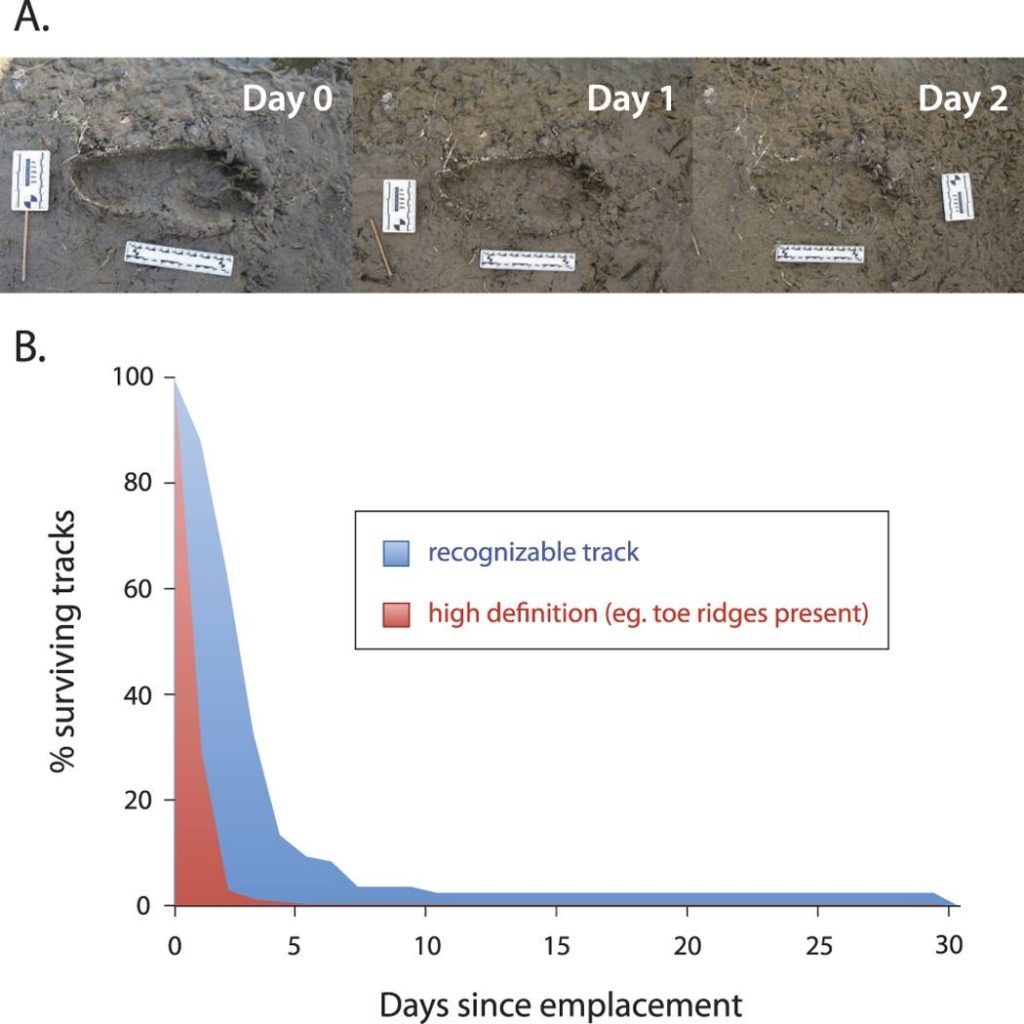
Needless to say, Roach’s experiment helped to explain not only my difficulty in coming across bigfoot tracks, but the difficulty facing other researchers as well, or for that matter the enthusiast who might just venture into the wilderness for a day. Without an associated sighting, a researcher literally needs to come across a print within a day of it having been made before it degenerates from fine detail to outline just a day or two later, followed by a guessing game, and then to dust or mud again within a week–and that assumes the print was firmly and fully impressed when laid down–a likely anomaly in itself in the terrain of the Pacific Northwest for example. Unfortunately, searching for tracks amounts to another needle in a haystack endeavor, especially when low bigfoot populations densities are taken into account. While some researchers have concluded that bigfoot deliberately does not leave tracks, this deliberation game is a wholly unlikely one. For all intents and purposes, bigfoot may as well be gliding across the land as is, and, perhaps, need only to avoid a few track conducive areas where it might encounter humans, which implies a certain critical faculty if so.
A seeming contradiction to this would be the Patterson-Gimlin tracks at Bluff Creek, which Bob Titmus was still able to cast some nine days later (Green, 2006). In written correspondence to John Green (2006), he testified that even the tracks that weren’t covered by bark were still in good shape, even at this later date. Roach’s 2016 study also revealed that an extreme minority of tracks will retain features longer under ideal conditions, which can vary even on the banks of Lake Turkana in terms of moisture content as just one example, with half a percent (.5%) of tracks retaining high definition until day four, while 2% of tracks were visible in outline at a month’s time. Not only was it fortuitous that Patterson and Gimlin were able to capture a female bigfoot on film that day, the culmination of an extreme commitment and passion, but it was also fortuitous that the silty banks of the Bluff Creek trackway conspired in their favor as well and proved ideal to preserve the tracks for an extended period of time for casting and study. I’m hardly an expert on soils, but a Bluff Creek soil sample did reach me courtesy of researcher Daniel Perez, author of Bigfoot at Bluff Creek, Big Footnotes, and editor of the Bigfoot Times. Examining it both visually and tactilely in my fingers and hand, the finer grains are so tiny that they leave a dust on the skin. In the sample I have, the majority of particles might be considered the size of sand grains, with the larger chip or pebble sized, and each tells the tale of the elements refining their surfaces. They sort naturally by size when shaken in a plastic baggie, with the finer grains on the bottom and the larger chips on top. To my untrained eye, this silt seems more conducive to potential long term preservation of tracks than other soils, like pure mud, which might give an ideal high definition track impression initially, but then fill quickly with water so it collapses. Meldrum (2007) describes the track site as “fine dampened sand that took the imprints with exceptional clarity.” The physical characteristics of the tiny component pieces were ideal as well: “The angular nature of the clasts facilitated excellent preservation of footprint detail” (Meldrum, 2007). So the female bigfoot, for all intents and purposes, walked across the most perfect canvas of nature’s creation in terms of track preservation.
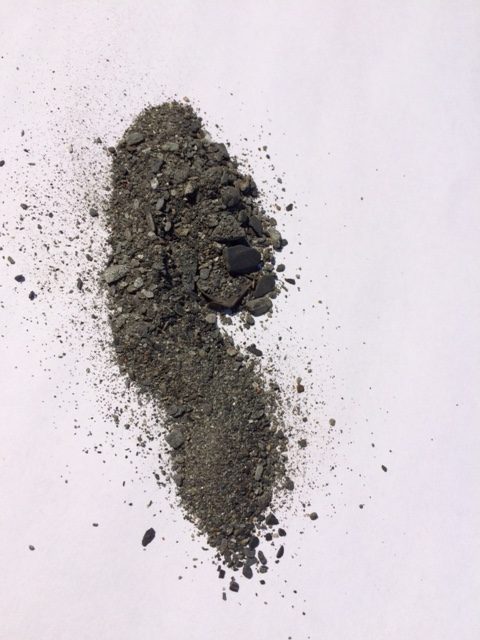
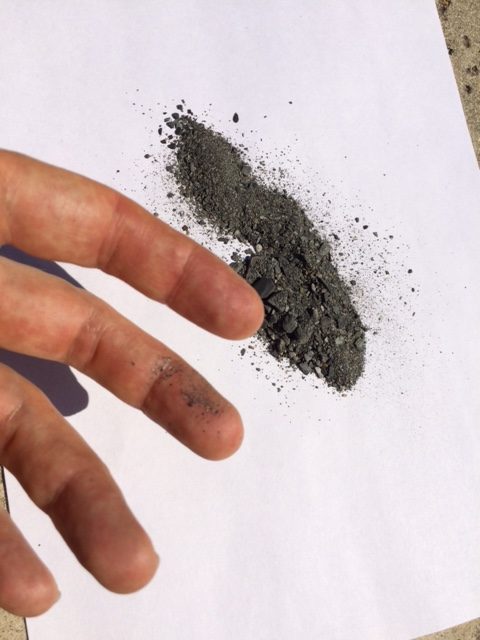
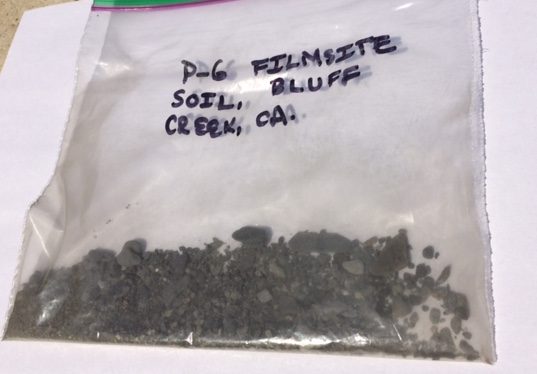
The weather also seems to have cooperated, despite what Green (1968) calls a “cloudburst” that forced Patterson and Gimlin prematurely out of the valley. The effects of the rain, in the form of distinct drops, which must have been brief and perhaps localized, can still be seen in the photographs taken by forestry worker Lyle Laverty when he visited the track site just a few days after Patterson and Gimlin left. The rain was not strong enough to wash away the tracks, and perhaps added just enough moisture to the uncovered tracks to aid in their preservation, acting as a kind of glue that seeped between the porous silt. This may very well be substantiated by Roach’s (2016) description of soils conducive to tracks and conditions affecting them: “Tracks can form anywhere on a landscape with fine-grained sediments, typically when wetted by surface water or rainfall, increasing the cohesion of the substrate. Temporary preservation of tracks depends on how well the definition of the track is maintained as the sediment dries and hardens.” In his visit to the site some nine days later, Titmus mentioned that the tracks of Patterson and Gimlin’s horses were still visible in the valley (Green, 2006), an additional clue that the rain did not turn out to be overly severe and may have had a hardening effect.
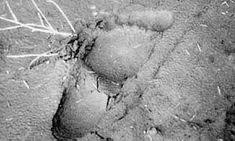
Since few, if any sites, especially when the unknowns of weather are factored in, will prove as conducive to track preservation as the 1960’s Bluff Creek drainage—and even its terrain has changed over 50 years later due to overgrowth, likely compromising much of it—the implications for today’s bigfoot researcher or enthusiast on the lookout for tracks (with no associated sighting or in a unique circumstance like road building) is that unless he or she comes across high definition prints within 24-48 hours after they have been left behind, it is likely a rather futile affair, though not impossible. The print will quickly degenerate into a recognizable outline, which, while still holding promise, will just as assuredly become unrecognizable soon enough. While some will argue that the much heavier bigfoot will impress a deeper track than a Homo sapiens in similar terrain, and this is no doubt true and will give it some greater odds of imprinting, it does not necessarily follow that the track will last all that much longer–if any longer–under anything less than ideal soil and weather conditions. In wet heavy mud, for example, toe ridges and the outline will collapse once water seeps in, which could be little more than seconds or minutes. It must be remembered that Roach’s (2016) study of the longevity of human footprints was in relation to other fauna in the data record, and the retainment of distinct features was “consistent with data from non-hominin fauna in similar environments.” We should not expect bigfoot tracks to deviate remarkably from other animals that, in some cases, are also much heavier than humans.
For those researchers fortunate enough to come across a discernable track or two where there was no associated sighting, it is more than likely the result of a heavy dedication to field work. For the researchers that I know who have accomplished this, this is the prevailing pattern, and congratulations to them in their grit and determination. For those who have come across tens or twenties or even more in terms of number of track finds, like Paul Freeman, the logic is impeccably simple. Freeman and his ilk came across the track finds because they placed them there, then immortalized their handiwork in plaster on the spot. It is even more absurd in the case of Freeman because included in his cast haul are gluteus cheeks, hand imprints, and shin imprints for example. He had to chance across a bigfoot within 24 hours on several different occasions that was practically doing calisthenics and left a record of it in the most malleable dirt. That is a laughable, exaggerated picture no doubt but I do it to prove a point. Much of the end game for any researcher is to weed out hoaxing in order to lay bare the truth…in this case the nature of the longevity of tracks in the wild and the sheer difficulty of coming across track finds without a sighting event or under quite unusual circumstances. It is not too far-fetched to state that in the field of bigfoot research, our own form of Drake’s equation could be applied to determine the odds of finding that perfectly placed bigfoot track, then coming across it within 24 hours, all the while having plaster with you or being able to quickly retrieve some, then adding to it the likelihood of finding several more near perfect prints over the years, and add to this several more factors still such as soil conditions and weather, as a means of weeding out the hoaxers.
Roach’s study also helps to clear up one small mystery that occurred years ago while I was backpacking in the Sierra. It was later in the day after I set up my tent, and, with a little time before sundown, I proceeded to explore along a ridge that had view enough that I could see the stream below and its sandy banks where it wasn’t overrun with scrub. At one point, I stopped and did a double-take because there appeared to be a large footprint next to the stream in the sand. I was deep in the wilderness in a steep slot canyon and well off the trail. It was a challenging climb down to the stream and while I was up for it, it was too late in the evening to tackle it, so I resolved to come back in the morning. It wasn’t a place I’d expect another backpacker to be getting into and I had not seen anyone. I marked the place with a stick in the ground, hiked further along the ridge, and confirmed the print’s location again when I turned around and headed to my tent a little later. When I got back in the morning, the print had vanished. I could see nothing but a sandy embankment. I was dumbfounded to say the least. It must have been a trick of the later evening light of the other day I thought. But that wasn’t satisfactory because the bank was still fully illuminated, the sun a different angle in the sky of course, but there was nothing to cast a shadow. There seemed no point in making the climb down to see little more than sand when I could hit the trail earlier so I gave it a mental shrug and walked away. That observation of the disappearing track stayed with me all day on the trail, and well beyond that as it turned out, a tiny unresolved mystery, almost but not quite crowded out in my mind by far bigger ones, and perhaps, just perhaps I have an explanation for it now and can finally lay it to rest.
Bibliography
Green, J. (2004). Historical overview and basic facts involved in the bigfoot or sasquatch phenomenon. Journal of Scientific Exploration, 18(1), 37-51. Retrieved from https://www.scientificexploration.org/docs/18/jse_18_1_green.pdf
Green, J. (1968). On the track of the sasquatch. Agassiz, Canada: Cheam Publishing Ltd.
Green, J. (2006). Sasquatch: The apes among us (2nd ed.). Surrey, Canada: Hancock House Publishers Ltd.
Meldrum, J. (2007). Ichnotaxonomy of giant tracks in North America. Cenozoic Vertebrate Tracks and Traces. Retrieved from https://pdfs.semanticscholar.org/c2ed/f0c924c39b4e0ba923fb577c59f9f8fccfe4.pdf
Roach, N. T. et al. Pleistocene footprints show intensive use of lake margin habitats by Homo erectus groups. Sci. Rep. 6, 26374; doi: 10.1038/srep26374 (2016). https://www.nature.com/articles/srep26374
Copyright 2020, T.A. Wilson, all rights reserved.